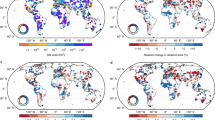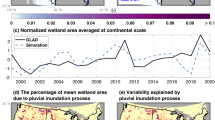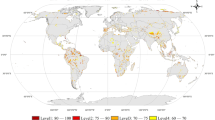Abstract
Wetlands have long been drained for human use, thereby strongly affecting greenhouse gas fluxes, flood control, nutrient cycling and biodiversity1,2. Nevertheless, the global extent of natural wetland loss remains remarkably uncertain3. Here, we reconstruct the spatial distribution and timing of wetland loss through conversion to seven human land uses between 1700 and 2020, by combining national and subnational records of drainage and conversion with land-use maps and simulated wetland extents. We estimate that 3.4 million km2 (confidence interval 2.9–3.8) of inland wetlands have been lost since 1700, primarily for conversion to croplands. This net loss of 21% (confidence interval 16–23%) of global wetland area is lower than that suggested previously by extrapolations of data disproportionately from high-loss regions. Wetland loss has been concentrated in Europe, the United States and China, and rapidly expanded during the mid-twentieth century. Our reconstruction elucidates the timing and land-use drivers of global wetland losses, providing an improved historical baseline to guide assessment of wetland loss impact on Earth system processes, conservation planning to protect remaining wetlands and prioritization of sites for wetland restoration4.
This is a preview of subscription content, access via your institution
Access options
Access Nature and 54 other Nature Portfolio journals
Get Nature+, our best-value online-access subscription
$29.99 / 30 days
cancel any time
Subscribe to this journal
Receive 51 print issues and online access
$199.00 per year
only $3.90 per issue
Buy this article
- Purchase on Springer Link
- Instant access to full article PDF
Prices may be subject to local taxes which are calculated during checkout




Similar content being viewed by others
Data availability
Data for national and subnational statistics of drained or converted areas, regional wetland percentage loss estimates, and gridded reconstruction of drained area per land use and cumulative—as well as natural wetland area—are available at https://doi.org/10.5281/zenodo.7293597.
Code availability
The scripts used to process input data, model and calibrate the wetland loss reconstruction, and produce the figures are publicly available at https://github.com/etiennefluetchouinard/wetland-loss-reconstruction.
References
Zedler, J. B. & Kercher, S. Wetland resources: status, trends, ecosystem services, and restorability. Annu. Rev. Environ. Resour. 30, 39–74 (2005).
Finlayson, C. M. et al. Millennium Ecosystem Assessment: Ecosystems and Human Well-being: Wetlands and Water Synthesis (World Resources Institute, 2005).
Davidson, N. C. How much wetland has the world lost? Long-term and recent trends in global wetland area. Mar. Freshwater Res. 65, 934 (2014).
Günther, A. et al. Prompt rewetting of drained peatlands reduces climate warming despite methane emissions. Nat. Commun. 11, 1644 (2020).
Schultz, B., Thatte, C. D. & Labhsetwar, V. K. Irrigation and drainage. Main contributors to global food production. Irrig. Drain. 54, 263–278 (2005).
Valipour, M. et al. The evolution of agricultural drainage from the earliest times to the present. Sustainability 12, 416 (2020).
Holden, J., Chapman, P. J. & Labadz, J. C. Artificial drainage of peatlands: hydrological and hydrochemical process and wetland restoration. Prog. Phys. Geogr. 28, 95–123 (2004).
Joosten, H. & Clarke, D. Wise Use of Mires and Peatlands (International Mire Conservation Group and International Peat Society, 2002).
van Asselen, S., Verburg, P. H., Vermaat, J. E. & Janse, J. H. Drivers of wetland conversion: a global meta-analysis. PLoS ONE 8, e81292 (2013).
Maron, M. et al. The many meanings of no net loss in environmental policy. Nat. Sustain. 1, 19–27 (2018).
Costanza, R. et al. The value of the world’s ecosystem services and natural capital. Nature 387, 253–260 (1997).
Page, S. E. & Hooijer, A. In the line of fire: the peatlands of Southeast Asia. Philos. Trans. R. Soc. Lond. B Biol. Sci. 371, 20150176 (2016).
Miettinen, J., Shi, C. & Liew, S. C. Land cover distribution in the peatlands of Peninsular Malaysia, Sumatra and Borneo in 2015 with changes since 1990. Glob. Ecol. Conserv. 6, 67–78 (2016).
Wada, Y. et al. Recent changes in land water storage and its contribution to sea level variations. Surv. Geophys. 38, 131–152 (2017).
Xu, J., Morris, P. J., Liu, J. & Holden, J. Hotspots of peatland-derived potable water use identified by global analysis. Nat. Sustain. 1, 246–253 (2018).
Sterling, S. M., Ducharne, A. & Polcher, J. The impact of global land-cover change on the terrestrial water cycle. Nat. Clim. Change 3, 385–390 (2013).
Abril, G. & Borges, A. V. Ideas and perspectives: carbon leaks from flooded land: do we need to replumb the inland water active pipe? Biogeosciences 16, 769–784 (2019).
Qiu, C. et al. Large historical carbon emissions from cultivated northern peatlands. Sci. Adv. 7, eabf1332 (2021).
Bahram, M. et al. Structure and function of the soil microbiome underlying N2O emissions from global wetlands. Nat. Commun. 13, 1430 (2022).
Paudel, R., Mahowald, N. M., Hess, P. G. M., Meng, L. & Riley, W. J. Attribution of changes in global wetland methane emissions from pre-industrial to present using CLM4.5-BGC. Environ. Res. Lett. 11, 034020 (2016).
Cheng, F. Y., Van Meter, K. J., Byrnes, D. K. & Basu, N. B. Maximizing US nitrate removal through wetland protection and restoration. Nature 588, 625–630 (2020).
Bullock, A. & Acreman, M. The role of wetlands in the hydrological cycle. Hydrol. Earth Syst. Sci. 7, 358–389 (2003).
Castellano, M. J., Archontoulis, S. V., Helmers, M. J., Poffenbarger, H. J. & Six, J. Sustainable intensification of agricultural drainage. Nat. Sustain. 2, 914–921 (2019).
IPCC. 2013 Supplement to the 2006 IPCC Guidelines for National Greenhouse Gas Inventories: Wetlands: Methodological Guidance on Lands with Wet and Drained Soils, and Constructed Wetlands for Wastewater Treatment (2013).
Tubiello, F., Biancalani, R., Salvatore, M., Rossi, S. & Conchedda, G. A worldwide assessment of greenhouse gas emissions from drained organic soils. Sustainability 8, 371 (2016).
Hugelius, G. et al. Large stocks of peatland carbon and nitrogen are vulnerable to permafrost thaw. Proc. Natl Acad. Sci. USA 117, 20438–20446 (2020).
Pongratz, J. et al. Models meet data: challenges and opportunities in implementing land management in Earth system models. Glob. Chang. Biol. 24, 1470–1487 (2018).
Intergovernmental Science-Policy Platform on Biodiversity and Ecosystem Services. Land Degradation Assessment (2018).
Ramsar Convention Secretariat, Ramsar Convention on Wetlands. Global Wetland Outlook: State of the World’s Wetlands and their Services to People (2018).
Winkler, M. G. & DeWitt, C. B. Environmental impacts of peat mining in the United States: documentation for wetland conservation. Environ. Conserv. 12, 317–330 (1985).
Darrah, S. E. et al. Improvements to the Wetland Extent Trends (WET) index as a tool for monitoring natural and human-made wetlands. Ecol. Indic. 99, 294–298 (2019).
Hu, S., Niu, Z., Chen, Y., Li, L. & Zhang, H. Global wetlands: potential distribution, wetland loss, and status. Sci. Total Environ. 586, 319–327 (2017).
Verhoeven, J. T. A. & Setter, T. L. Agricultural use of wetlands: opportunities and limitations. Ann. Bot. 105, 155–163 (2010).
Pavelis, G. A. Farm Drainage in the United States: History, Status, and Prospects (Economic Research Service, 1987).
Leifeld, J. & Menichetti, L. The underappreciated potential of peatlands in global climate change mitigation strategies. Nat. Commun. 9, 1071 (2018).
Rooney, R. C., Bayley, S. E. & Schindler, D. W. Oil sands mining and reclamation cause massive loss of peatland and stored carbon. Proc. Natl Acad. Sci. USA 109, 4933–4937 (2012).
Acreman, M. & Holden, J. How wetlands affect floods. Wetlands 33, 773–786 (2013).
Creed, I. F. et al. Enhancing protection for vulnerable waters. Nat. Geosci. 10, 809–815 (2017).
Cohen, M. J. et al. Do geographically isolated wetlands influence landscape functions? Proc. Natl Acad. Sci. USA 113, 1978–1986 (2016).
Borges, A. V. et al. Divergent biophysical controls of aquatic CO2 and CH4 in the World’s two largest rivers. Sci. Rep. 5, 15614 (2015).
Melton, J. R. et al. Present state of global wetland extent and wetland methane modelling: conclusions from a model inter-comparison project (WETCHIMP). Biogeosciences 10, 753–788 (2013).
Ritzema, H. P. Drain for gain: managing salinity in irrigated lands—a review. Agric. Water Manage. 176, 18–28 (2016).
Gallant, A. The challenges of remote monitoring of wetlands. Remote Sens. 7, 10938–10950 (2015).
de Zeeuw, J. W. Peat and the Dutch golden age. The historical meaning of energy-attainability. A. A. G. Bijdr. 21, 3–31 (1978).
Woodward, C., Shulmeister, J., Larsen, J., Jacobsen, G. E. & Zawadzki, A. The hydrological legacy of deforestation on global wetlands. Science 346, 844–847 (2014).
Feick, S., Siebert, S. & Döll, P. A Digital Global Map of Artificially Drained Agricultural Areas (Johann Wolfgang Goethe-Universität Frankfurt am Main, 2005); https://www.uni-frankfurt.de/45217762/FHP_04_Feick_et_al_2005.pdf.
Irrigation and Drainage in the World – A Global Review Vols I–III (International Commission on Irrigation & Drainage, 1982).
FAOSTAT (Food and Agriculture Organization of the United Nations, accessed 21 October 2021); https://www.fao.org/faostat/en/.
McCorvie, M. R. & Lant, C. L. Drainage district formation and the loss of Midwestern wetlands, 1850–1930. Agric. Hist. 67, 13–39 (1993).
AQUASTAT (Food and Agriculture Organization of the United Nations, accessed 17 August 2018); https://www.fao.org/aquastat/en/.
Kearns, K. C. Development of the Irish peat fuel industry. Am. J. Econ. Sociol. 37, 179–193 (1978).
Schultz, B., Zimmer, D. & Vlotman, W. F. Drainage under increasing and changing requirements. Irrig. Drain. Syst. 56, S3–S22 (2007).
Niu, Z. et al. Mapping wetland changes in China between 1978 and 2008. Chin. Sci. Bull. 57, 2813–2823 (2012).
Dahl, T. E. Wetlands Losses in the United States 1780’s to 1980’s: Report to Congress (US Department of Energy, 1990).
Zhang, Z., Fluet-Chouinard, E. & Jensen, K. Development of the global dataset of Wetland Area and Dynamics for Methane Modeling (WAD2M). Earth Syst. Sci. Data 13, 2001–2023 (2021).
Prigent, C., Jimenez, C. & Bousquet, P. Satellite‐derived global surface water extent and dynamics over the last 25 years (GIEMS‐2). J. Geophys. Res. Atmos. 125, e2019JD030711 (2020).
Lehner, B. & Döll, P. Development and validation of a global database of lakes, reservoirs and wetlands. J. Hydrol. 296, 1–22 (2004).
Pekel, J.-F., Cottam, A., Gorelick, N. & Belward, A. S. High-resolution mapping of global surface water and its long-term changes. Nature 540, 418–422 (2016).
Carroll, M. L., Townshend, J. R., DiMiceli, C. M., Noojipady, P. & Sohlberg, R. A. A new global raster water mask at 250 m resolution. Int. J. Digit. Earth 2, 291–308 (2009).
Portmann, F. T., Siebert, S. & Döll, P. MIRCA2000–global monthly irrigated and rainfed crop areas around the year 2000: a new high-resolution data set for agricultural and hydrological modeling. Global Biogeochem. Cycles 24, March 2010 (2010).
Hugelius, G. et al. The Northern Circumpolar Soil Carbon Database: spatially distributed datasets of soil coverage and soil carbon storage in the northern permafrost regions. Earth Syst. Sci. Data 5, 3–13 (2013).
Gumbricht, T. et al. An expert system model for mapping tropical wetlands and peatlands reveals South America as the largest contributor. Glob. Chang. Biol. 23, 3581–3599 (2017).
Zhang, Z., Zimmermann, N. E., Kaplan, J. O. & Poulter, B. Modeling spatiotemporal dynamics of global wetlands: comprehensive evaluation of a new sub-grid TOPMODEL parameterization and uncertainties. Biogeosciences 13, 1387–1408 (2016).
Beven, K. J. & Kirkby, M. J. A physically based, variable contributing area model of basin hydrology. Hydrol. Sci. Bull. 24, 43–69 (1979).
Wania, R. et al. Present state of global wetland extent and wetland methane modelling: methodology of a model inter-comparison project (WETCHIMP). Geosci. Model Dev. 6, 617–641 (2013).
Goldewijk, K. K., Beusen, A., Doelman, J. & Stehfest, E. Anthropogenic land use estimates for the Holocene – HYDE 3.2. Earth Syst. Sci. Data 9, 927–953 (2017).
Goldewijk, K. K., Beusen, A., Van Drecht, G. & De Vos, M. The HYDE 3.1 spatially explicit database of human-induced global land-use change over the past 12,000 years. Global Ecol. Biogeogr. 20, 73–86 (2011).
Hurtt, G. C. et al. Harmonization of global land use change and management for the period 850–2100 (LUH2) for CMIP6. Geosci. Model Dev. 13, 5425–5464 (2020).
Xu, J., Morris, P. J., Liu, J. & Holden, J. PEATMAP: refining estimates of global peatland distribution based on a meta-analysis. Catena 160, 134–140 (2018).
Padfield, D. & Matheson, D. P. A. nls.multstart: Robust non-linear regression using AIC scores. R Project https://mran.microsoft.com/snapshot/2021-08-04/web/packages/nls.multstart/index.html (2020).
Smedema, L. K., Abdel-Dayem, S. & Ochs, W. J. Drainage and agricultural development. Irrig. Drain. Syst. 14, 223–235 (2000).
Murphy, F., Devlin, G. & McDonnell, K. Benchmarking environmental impacts of peat use for electricity generation in Ireland—a life cycle assessment. Sustain. Sci. Pract. Policy 7, 6376–6393 (2015).
Denham, T. Archaeological evidence for mid-Holocene agriculture in the interior of Papua New Guinea: a critical review. Archaeol. Oceania 38, 159–176 (2003).
Fuller, D. Q. & Qin, L. Water management and labour in the origins and dispersal of Asian rice. World Archaeol. 41, 88–111 (2009).
Bellwood, P. The checkered prehistory of rice movement southwards as a domesticated cereal—from the Yangzi to the Equator. Rice 4, 93–103 (2011).
Vörösmarty, C. J. & Fekete, B. ISLSCP II river routing data (STN-30p). ORNL DAAC https://daac.ornl.gov/cgi-bin/dsviewer.pl?ds_id=1005 (2011).
Acknowledgements
Funding for this work was provided by a postgraduate scholarship from the Natural Sciences and Engineering Research Council of Canada (no. PGSD2-471651-2015), the David and Lucille Packard Fellowship in Science and Engineering and National Science Foundation (grant no. DEB-1115025), a DAAD visit to Bonn Universität and by the Gordon and Betty Moore Foundation through grant no. GBMF5439 (Advancing Understanding of the Global Methane Cycle) to Stanford University supporting the Methane Budget activity for the Global Carbon Project. B.D.S. was funded by the Swiss National Science Foundation (grant no. PCEFP2_181115).
Author information
Authors and Affiliations
Contributions
E.F.-C. conceived and designed the study, with input from J.R.M., B.D.S., A.M., Z.Z., B.P., P.B.M. and R.B.J. E.F.-C., S.S. and T.M. compiled drainage data. Wetland area data were provided by Z.Z., B.D.S., J.R.M. and B.L. Land-use data were provided by K.K.G. E.F.-C. developed the model calibration, with advice from B.D.S., J.M. and Z.Z. E.F.-C. wrote the manuscript with input from P.B.M., and all authors edited the final version.
Corresponding author
Ethics declarations
Competing interests
The authors declare no competing interests.
Peer review
Peer review information
Nature thanks Steve Frolking, James Megonigal, Nicholas Murray and the other, anonymous, reviewer(s) for their contribution to the peer review of this work. Peer reviewer reports are available.
Additional information
Publisher’s note Springer Nature remains neutral with regard to jurisdictional claims in published maps and institutional affiliations.
Supplementary information
Supplementary Information
This file contains Supplementary figs, tables and references.
Rights and permissions
Springer Nature or its licensor (e.g. a society or other partner) holds exclusive rights to this article under a publishing agreement with the author(s) or other rightsholder(s); author self-archiving of the accepted manuscript version of this article is solely governed by the terms of such publishing agreement and applicable law.
About this article
Cite this article
Fluet-Chouinard, E., Stocker, B.D., Zhang, Z. et al. Extensive global wetland loss over the past three centuries. Nature 614, 281–286 (2023). https://doi.org/10.1038/s41586-022-05572-6
Received:
Accepted:
Published:
Issue Date:
DOI: https://doi.org/10.1038/s41586-022-05572-6
This article is cited by
-
Revealing the hidden carbon in forested wetland soils
Nature Communications (2024)
-
Global conservation priorities for wetlands and setting post-2025 targets
Communications Earth & Environment (2024)
-
Long-term wetland biomonitoring highlights the differential impact of land use on macroinvertebrate diversity in Dongting Lake in China
Communications Earth & Environment (2024)
-
Quantifying peatland land use and CO2 emissions in Irish raised bogs: mapping insights using Sentinel-2 data and Google Earth Engine
Scientific Reports (2024)
-
Labile organic matter promotes nitrogen retention in natural and constructed gulf coast marshes
Biogeochemistry (2024)
Comments
By submitting a comment you agree to abide by our Terms and Community Guidelines. If you find something abusive or that does not comply with our terms or guidelines please flag it as inappropriate.



